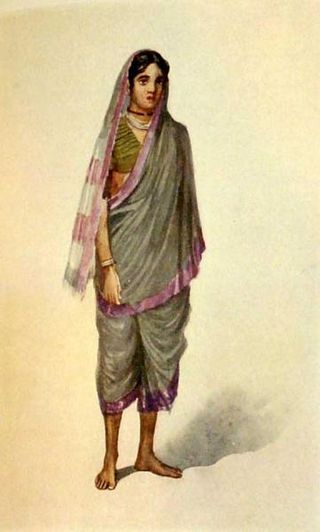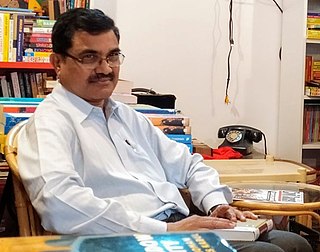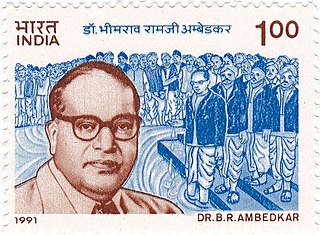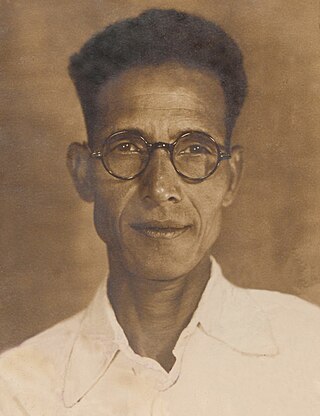Related Research Articles

Bhimrao Ramji Ambedkar was an Indian jurist, economist, social reformer and political leader who headed the committee drafting the Constitution of India from the Constituent Assembly debates, served as Law and Justice minister in the first cabinet of Jawaharlal Nehru, and inspired the Dalit Buddhist movement after renouncing Hinduism.

The Dalit Buddhist movement is a religious as well as a socio-political movement among Dalits in India which was started by B. R. Ambedkar. It re-interpreted Buddhism and created a new school of Buddhism called Navayana. The movement has sought to be a socially and politically engaged form of Buddhism.

Jyotirao Govindrao Phule was an Indian social activist, businessman, anti-caste social reformer and writer from Maharashtra. His work extended to many fields, including eradication of untouchability and the caste system and for his efforts in educating women and oppressed caste people. He and his wife, Savitribai Phule, were pioneers of women's education in India. Phule started his first school for girls in 1848 in Pune at Tatyasaheb Bhide's residence or Bhidewada. He, along with his followers, formed the Satyashodhak Samaj to attain equal rights for people from lower castes. People from all religions and castes could become a part of this association which worked for the upliftment of the oppressed classes. Phule is regarded as an important figure in the social reform movement in Maharashtra.The honorific Mahātmā, was first applied to him in 1888 at a special program honoring him in Mumbai.
Untouchability is a form of social institution that legitimises and enforces practices that are discriminatory, humiliating, exclusionary and exploitative against people belonging to certain social groups. Although comparable forms of discrimination are found all over the world, untouchability involving the caste system is largely unique to South Asia.

Dalit is a term first coined by Jyotirao Phule for untouchables and outcasts. It is the lowest stratum of the castes in the Indian subcontinent. Dalits were excluded from the fourfold varna of the caste hierarchy and were seen as forming a fifth varna, also known by the name of Panchama. Several scholars have drawn parallels between Dalits and the Burakumin of Japan, the Baekjeong of Korea and the peasant class of the medieval European feudal system.

Mahar is a caste found majorly in the state of Maharashtra and neighbouring areas. Most of Maharas trace their origin with amalgamation of Chamar craftmen from North India and local Maharathi Andhra-Naga tribe of Vidharbha(vessels of Mauryans) in times of first phase of urbanization in South India about 5th-4th century BCE. Mahavamsa mentions Maharathi were devout followers of Buddhism. Many Maharas believe Stupas of Bhon and Pauni were commissioned by Mahar chieftains in orders of Mauryan emperor Ashoka. An inscription from Bharhut Stupa dated to 2nd century BCE mentioned construction of a pillar was commissioned by Samaka, a student of Mahara. Maharas worship legendary farmer hero Mahasammat Raja who was the first farmer king elected by other farmers to rule them. The Maharas believe they are descendant of Mahasammat Raja,, the buddhist founder of Suriya Vassi Khattiyas or Kshtriyas of Solar dynasty.

Chokhamela was a Hindu saint in Maharashtra, India in the 14th century. He belonged to the Mahar caste,, which was considered that time one of the low castes in India. He was born at Mehuna Raja, a village in Deulgaon Raja Taluka of Buldhana district. He lived at Mangalvedha in Maharashtra. He wrote many Abhangas. One of his known Abhangas is 'Abir Gulal Udhlit Rang". Social activist Arvind Prabhakar Kayande Started Celebrating "Chokhamela Festival" in Deulgaon Raja. He was one of the first low-cast poets in India.

Arun Krushnaji Kamble was an Indian Marathi language writer, professor, Politician, and Dalit activist. Arun Kamble, President and one of the founding members of Dalit Panthers of India, worked as a Head of Marathi department at University of Mumbai. He was the National General Secretary of Janata Dal. He took many major decisions in favour of Dalit, Backward Class and Minorities.
Kamble is a Marathi Indian surname commonly used by communities residing in Maharashtra. The word "kamble" is literally translated as "cotton blankets" and could very well be derived from it; though there also existed clan, namely Sonkamble, and this could be its derivation, too.
Dalit literature is a genre of Indian writing that focuses on the lives, experiences, and struggles of the Dalit community, who have faced caste-based oppression and discrimination for centuries. This literature encompasses various Indian languages such as Marathi, Bangla, Hindi, Kannada, Punjabi, Sindhi, Odia and Tamil and includes diverse narratives like poems, short stories, and autobiographies. The movement originated in response to the caste-based social injustices in mid-twentieth-century independent India and has since spread across various Indian languages, critiquing caste practices and experimenting with different literary forms.
Gaekwad is a surname native to the Indian state of Maharashtra. The surname is found among the Marathas, Kolis and in Scheduled castes. It is also a common surname among Bharadis, Dhor, and Mahar communities of Maharashtra.

Anand Teltumbde is an Indian scholar, writer, and human rights activist who is a management professor at the Goa Institute of Management. He has written extensively about the caste system in India and has advocated for the rights of Dalits.

Eleanor Zelliot was an American writer, professor of Carleton College and specialist on the India, Southeast Asia, Vietnam, women of Asia, Untouchables, and social movements.

Mahad Satyagraha or Chavdar Tale Satyagraha was a satyagraha led by B. R. Ambedkar on 20 March 1927 to allow untouchables to use water in a public tank in Mahad, Maharashtra, India. The day is observed as Social Empowerment day in India.

Ramchandra Babaji More was a political leader and campaigner with a particular focus around the struggle against the Caste system in India and Class exploitation in the Indian subcontinent.
Gangadhar Nilkanth Sahasrabuddhe was an Indian social activist from Maharashtra. He was born in a Marathi Chitpawan Brahmin family and belonged to the Social Service League. Along with other activists - Surendranath Tipnis, chairman of the Mahad Municipality and A.V. Chitre, he was instrumental in helping Babasaheb Ambedkar during the Mahad Satyagraha. During the satyagraha he burnt the book Manusmriti. Later, he went on to become the editor of Ambedkar's weekly 'Janata'.
Surendranath Tipnis was the president of the Mahad Municipality in the early 1900s and a social activist. He was born in a CKP family. Along with other progressive social activists of the time such as A.V. Chitre and the Chitpawan Brahmin G. N. Sahasrabudhe, he was instrumental in helping Babasaheb Ambedkar during the Mahad Satyagraha. He declared Mahad's public spaces open to untouchables and invited Ambedkar to hold a meeting at Mahad in 1927. Later, he went on to become an MLA in Ambedkar's Independent Labour Party. He was awarded the titles 'Dalitmitra'(friend of the dalits) and 'Nanasaheb'.
Baby Kamble, commonly known as Babytai Kamble, was an Indian activist and writer. She was born into an untouchable caste, Mahar, the largest untouchable community in Maharashtra. She was a well-known Dalit activist and writer who was inspired by B. R. Ambedkar, prominent dalit leader. Kamble and her family converted to Buddhism and remained lifelong practicing Buddhists. In her community, she came to be admired as a writer and was fondly called as Tai. She is widely remembered and loved by the Dalit community for her contributions of powerful literary and activist work. She is one of the earliest women writers from the untouchable communities whose distinctive reflexive style of feminist writing setting her apart from other Dalit writers and upper caste women writers who gaze was limited and reflexivity incarcerated in caste and masculinity.
References
- 1 2 3 Zelliot, Eleanor (2010). "India's Dalits: Racism and Contemporary Change". Global Dialogue. 12 (2). Archived from the original on 2013-04-30.
- 1 2 3 4 5 Jadhav, K. N. (1991). Dr. Ambedkar: Life and Mission. Popular Prakashan. pp. 9–10. ISBN 978-8-17154-329-8.
- 1 2 Valunjkar, T. N. (1998). "Dalit Social Consciousness in Western Maharashtra in Colonial Period 1880-1910". In Pathak, Bindeshwar (ed.). Continuity and Change in Indian Society: Essays in Memory of Late Prof. Narmadeshwar Prasad. Concept Publishing Company. pp. 207–208. ISBN 978-8-17022-726-7.
- ↑ Teltumbde, Anand (2016). Dalits: Past, present and future. Routledge. p. 54. ISBN 978-1-31552-643-0.
- 1 2 3 4 5 Teltumbde, Anand (2016). Dalits: Past, present and future. Routledge. p. 53. ISBN 978-1-31552-643-0.
- ↑ Valunjkar, T. N. (1998). "Dalit Social Consciousness in Western Maharashtra in Colonial Period 1880-1910". In Pathak, Bindeshwar (ed.). Continuity and Change in Indian Society: Essays in Memory of Late Prof. Narmadeshwar Prasad. Concept Publishing Company. p. 214. ISBN 978-8-17022-726-7.
- ↑ Smith, Donald Eugene (2015). South Asian Politics and Religion. Princeton University Press. p. 194. ISBN 978-1-40087-908-3.
- ↑ Jaffrelot, Christophe (2005). Dr. Ambedkar and untouchability: fighting the Indian caste system. Columbia University Press. ISBN 0231136021.
- ↑ Rao, Anupama (2009). The Caste Question: Dalits and the Politics of Modern India. University of California Press. p. 30. ISBN 978-0520257610.
- 1 2 Zelliott, Eleanor (1978). "Religion and Legitimation in the Mahar Movement". In Smith, Bardwell L. (ed.). Religion and the Legitimation of Power in South Asia. Brill. pp. 88–90. ISBN 9004056742.
- ↑ Kamble, N. D. (1983). Deprived castes and their struggle for equality . Ashish Publisher House. pp. 129–132.
- ↑ Teltumbde, Anand (2016). Dalits: Past, present and future. Routledge. p. 52. ISBN 978-1-31552-643-0.